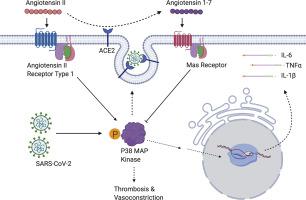当前位置:
X-MOL 学术
›
J. Mol. Cell. Cardiol.
›
论文详情
Our official English website, www.x-mol.net, welcomes your
feedback! (Note: you will need to create a separate account there.)
p38 MAPK inhibition: A promising therapeutic approach for COVID-19.
Journal of Molecular and Cellular Cardiology ( IF 4.9 ) Pub Date : 2020-05-15 , DOI: 10.1016/j.yjmcc.2020.05.007 Joseph M Grimes 1 , Kevin V Grimes 2
Journal of Molecular and Cellular Cardiology ( IF 4.9 ) Pub Date : 2020-05-15 , DOI: 10.1016/j.yjmcc.2020.05.007 Joseph M Grimes 1 , Kevin V Grimes 2
Affiliation

|
COVID-19, caused by the SARS-CoV-2 virus, is a major source of morbidity and mortality due to its inflammatory effects in the lungs and heart. The p38 MAPK pathway plays a crucial role in the release of pro-inflammatory cytokines such as IL-6 and has been implicated in acute lung injury and myocardial dysfunction. The overwhelming inflammatory response in COVID-19 infection may be caused by disproportionately upregulated p38 activity, explained by two mechanisms. First, angiotensin-converting enzyme 2 (ACE2) activity is lost during SARS-CoV-2 viral entry. ACE2 is highly expressed in the lungs and heart and converts Angiotensin II into Angiotensin 1-7. Angiotensin II signals proinflammatory, pro-vasoconstrictive, pro-thrombotic activity through p38 MAPK activation, which is countered by Angiotensin 1-7 downregulation of p38 activity. Loss of ACE2 upon viral entry may tip the balance towards destructive p38 signaling through Angiotensin II. Second, SARS-CoV was previously shown to directly upregulate p38 activity via a viral protein, similar to other RNA respiratory viruses that may hijack p38 activity to promote replication. Given the homology between SARS-CoV and SARS-CoV-2, the latter may employ a similar mechanism. Thus, SARS-CoV-2 may induce overwhelming inflammation by directly activating p38 and downregulating a key inhibitory pathway, while simultaneously taking advantage of p38 activity to replicate. Therapeutic inhibition of p38 could therefore attenuate COVID-19 infection. Interestingly, a prior preclinical study showed protective effects of p38 inhibition in a SARS-CoV mouse model. A number of p38 inhibitors are in the clinical stage and should be considered for clinical trials in serious COVID-19 infection.
中文翻译:

p38 MAPK 抑制:一种有前景的 COVID-19 治疗方法。
COVID-19 由 SARS-CoV-2 病毒引起,由于其对肺部和心脏的炎症作用,是发病率和死亡率的主要来源。 p38 MAPK 通路在促炎细胞因子(例如 IL-6)的释放中发挥着至关重要的作用,并且与急性肺损伤和心肌功能障碍有关。 COVID-19 感染中的压倒性炎症反应可能是由 p38 活性过度上调引起的,有两种机制可以解释。首先,血管紧张素转换酶 2 (ACE2) 活性在 SARS-CoV-2 病毒进入期间丧失。 ACE2 在肺和心脏中高表达,并将血管紧张素 II 转化为血管紧张素 1-7。血管紧张素 II 通过 p38 MAPK 激活发出促炎、促血管收缩、促血栓形成活性信号,而血管紧张素 1-7 下调 p38 活性可抵消这一作用。病毒进入后 ACE2 的丢失可能会导致通过血管紧张素 II 破坏性 p38 信号传导的平衡。其次,SARS-CoV 此前已被证明可通过病毒蛋白直接上调 p38 活性,类似于其他可能劫持 p38 活性以促进复制的 RNA 呼吸道病毒。鉴于 SARS-CoV 和 SARS-CoV-2 之间的同源性,后者可能采用类似的机制。因此,SARS-CoV-2可能通过直接激活p38并下调关键抑制途径来诱导压倒性炎症,同时利用p38活性进行复制。因此,治疗性抑制 p38 可以减轻 COVID-19 感染。有趣的是,先前的临床前研究表明 p38 抑制对 SARS-CoV 小鼠模型具有保护作用。许多 p38 抑制剂正处于临床阶段,应考虑用于严重 COVID-19 感染的临床试验。
更新日期:2020-05-16
中文翻译:

p38 MAPK 抑制:一种有前景的 COVID-19 治疗方法。
COVID-19 由 SARS-CoV-2 病毒引起,由于其对肺部和心脏的炎症作用,是发病率和死亡率的主要来源。 p38 MAPK 通路在促炎细胞因子(例如 IL-6)的释放中发挥着至关重要的作用,并且与急性肺损伤和心肌功能障碍有关。 COVID-19 感染中的压倒性炎症反应可能是由 p38 活性过度上调引起的,有两种机制可以解释。首先,血管紧张素转换酶 2 (ACE2) 活性在 SARS-CoV-2 病毒进入期间丧失。 ACE2 在肺和心脏中高表达,并将血管紧张素 II 转化为血管紧张素 1-7。血管紧张素 II 通过 p38 MAPK 激活发出促炎、促血管收缩、促血栓形成活性信号,而血管紧张素 1-7 下调 p38 活性可抵消这一作用。病毒进入后 ACE2 的丢失可能会导致通过血管紧张素 II 破坏性 p38 信号传导的平衡。其次,SARS-CoV 此前已被证明可通过病毒蛋白直接上调 p38 活性,类似于其他可能劫持 p38 活性以促进复制的 RNA 呼吸道病毒。鉴于 SARS-CoV 和 SARS-CoV-2 之间的同源性,后者可能采用类似的机制。因此,SARS-CoV-2可能通过直接激活p38并下调关键抑制途径来诱导压倒性炎症,同时利用p38活性进行复制。因此,治疗性抑制 p38 可以减轻 COVID-19 感染。有趣的是,先前的临床前研究表明 p38 抑制对 SARS-CoV 小鼠模型具有保护作用。许多 p38 抑制剂正处于临床阶段,应考虑用于严重 COVID-19 感染的临床试验。











































 京公网安备 11010802027423号
京公网安备 11010802027423号